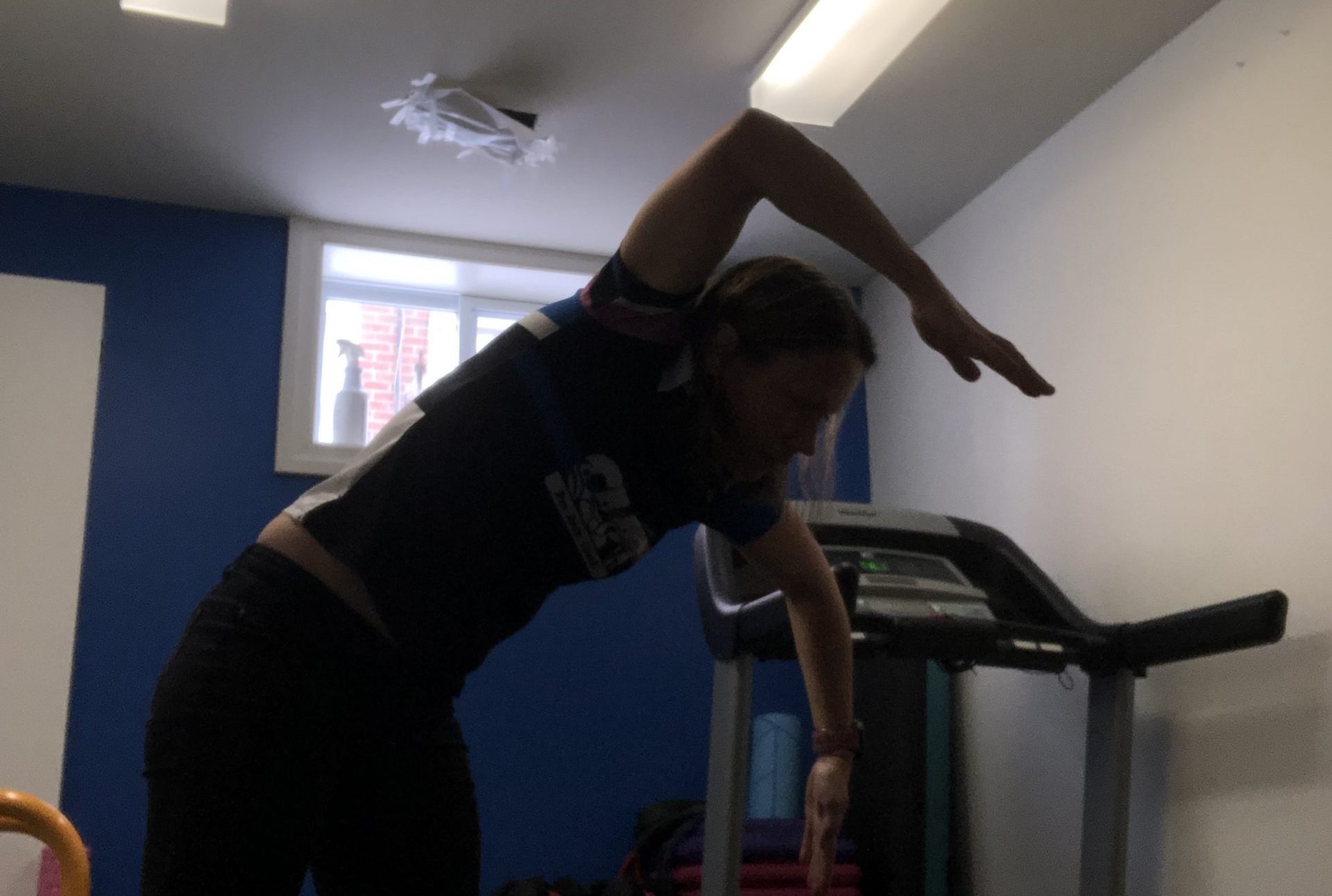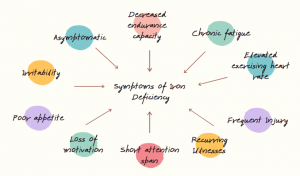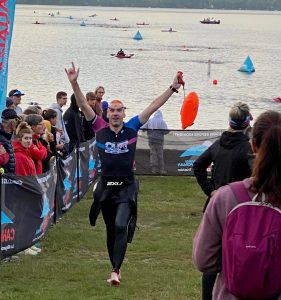Components of the Swim Stroke:
There are four or five separate parts of the swim stroke to think about – and in this case we are going to break it down into five and conceptualize what you are trying to accomplish with each part.
- Hand Entry: Think of hand entry as the start of your set up for the power portion of the stroke. The hand should start to drive into the water when your hand reaches your forehead during the recovery portion of the stroke. Drive the hand into the water at an angle of about 45-60 deg degrees to the water surface. The elbow should extend to about 95% – NOT locking out at 100% and being careful to always keep the elbow directed upwards and always having the elbow positioned higher than the wrist. You should begin to feel the water and think of starting to grab ahold of it, like positioning your arm and shoulder so you are ready to start “wrapping your arm around a barrel”.
- Catch: From hand entry we start to go into the catch. From hand entry you maintain that high elbow position (which you should ALWAYS be maintaining throughout the entire swim stroke) and move into a “forearm vertical” position. So, grab the water from hand entry, keep your elbow in the same position and drop your wrist and hand down towards the bottom of the pool, getting into a vertical forearm “catch” position as far in front of your body as your shoulder flexibility allows. The catch is the most important part of your stroke, as it sets you up to use your entire forearm as well as your wrist and hand as a paddle to pull and push the water and accelerate your body forward in the water. Keep in mind that hand entry and the catch are the set up portions of the stroke – they should be relaxed, they are setting you up for an efficient and powerful stroke but the powerful part has not happened yet.
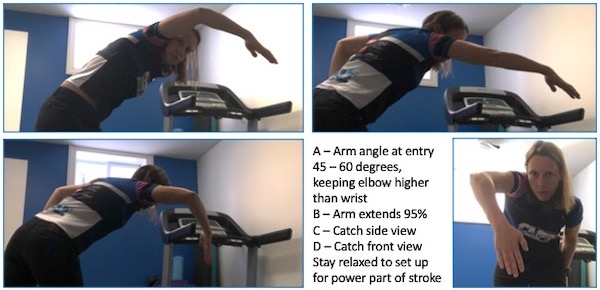
- Pull: Think of the pull as the first part of the power phase of the stroke. Once you have your vertical forearm set up in the catch, feel the water on your whole forearm and with your wrist and hand and start to accelerate your hand to the hip as you use your core to drive rotation. Feel acceleration as you pull to the hip.
- Push: Think of the push as the second part and final part of the power phase of the stroke. Once you pull to the hip, you push past the hip and extend the elbow – again to 95% and not full locked out extension. You should continue to feel acceleration of the hand as you do this and feel acceleration of your body through the water.
- Recovery: The recovery portion of the stroke is from the end of the push to hand entry. It should be relaxed and easy. Think of the elbow being pulled up on a puppet string towards the ceiling or the sky and the rest of the arm to the fingertips dangling down relaxed. The hand should move relatively close to the body as you recover, and this will be made easier and more natural as your body rotation starts to improve.
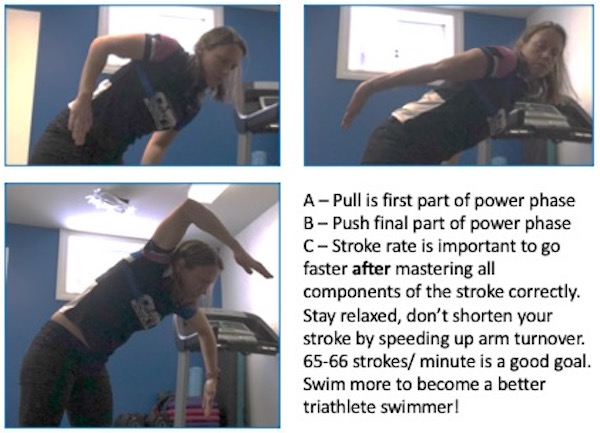
Rate, Rhythm and Shape:
There is lots to be read about catch up stroke vs. non catch up stroke. Which is better? In our opinion, it does not matter. As long as you have grasped and perfected all of the components of the swim stroke above, swim with whatever rhythm feels the most natural for you, catch up or not.
Stroke rate is important. If you can take more strokes in a minute, you have more opportunity to drive your body forward in the water each minute, leading to faster swimming. However, it is important that as you increase your stroke rate you can maintain your form and not end up shortening your stroke and missing out on the pull and push power phase of your stroke, making yourself less efficient. Once you have all five components of your stroke going well, you can work on slowly and gradually increasing your stroke rate provided you can stay relaxed and you do not shorten your stroke. Sixty five to sixty six strokes per minute is a good goal to eventually get to as a triathlete swimmer.
What about the shape of the pull? Should it be S-Shape? Unless you are an advanced swimmer, our recommendation is that for now you keep it simple and just pull backward. As you get more advanced, you can start to work on an S-Shape or “boomerang” shape swim stroke where you pull in toward your belly button and then pull outward slightly past the hip. Don’t get too caught up in this right now as it adds complexity to the stroke that most of us do not need to worry about at this point.
What is the best way to become a better swimmer sooner?
Swim volume is the most important thing related to getting better at swimming. Over twelve thousand yards per week is the point where you really start to see improvements in swim times. You will improve with less than this, but the twelve thousand yards is where that improvement starts to accelerate. Keep in mind that frequency of swimming is important as well as distance per swim. The more often you can get in the pool and get your body practicing the mechanics, the better.
How important are drills?
Drill can be helpful to make you realize your weakness – and work on a specific weakness. However, we believe that swimming more is more useful than doing more drills. As your body spends more time in the water, it gets more comfortable in the water, and gets more efficient. All that = improved swimming.
Here are some specific drills and how they can help:
- Fist swimming: put both of your hands in fists and swim like that. This is our favorite drill. First swimming works on the catch, the most important part of the swim stroke. Putting your hands in fists takes away your hand “paddle” which makes it more important that you get a vertical forearm in the catch to pull with if you are going to move forward at all with fist swimming. It also allows you to work on and feel hand/arm acceleration through the water when you take away the hand paddle because you feel less resistance.
- Head up free: This is a good drill for working on leading the stroke with your shoulders. Most triathletes are tight through the shoulders and upper back, making your swim stroke tight, tense and less fluid. Head up free swimming helps to teach your body how to lead the swim stroke with the shoulders rather than muscling your way through it.
- One arm free: This drill works on balance in the water and allows you to work on your catch and body position with arm at a time. This can be done with the other arm leading straight ahead and breathing on the side of the one arm stroke or it can be done with other arm at your side and breathing to that opposite side.
- 2 stroke free: This is when you take two strokes with one arm and two strokes with other arm, typically breathing on the first stroke of each side. This slows things down a bit and allows you to focus on one side at a time a little more for rotation and catch.
In summary, the first thing to do is understand your stroke components and what the goal of each part of the stroke is. Conceptualizing this will help you understand what you are trying to do and why – which will always help you improve at something faster. Next, work on slowly increasing your stroke rate with your strong and efficient stroke while adding in some drills to your warm and cool down to work on your own specific weaknesses, realizing that although there is value to drills, the most value comes from swimming more. Look at your schedule, map out the times you can get to the pool or the lake, and challenge yourself to add one more swim per week, no matter how long it is.
CL Performance Training is offering two training camps in 2022 where you can have an opportunity for coach-led workouts for pool training in Collingwood (April 28 – May 1) and open water swimming in Muskoka (June 3-5).
For more information on swimming, cycling and running, and if you have any questions about any of our one-on-one online coaching programs, please contact us at clperformancetraining@gmail.com.
